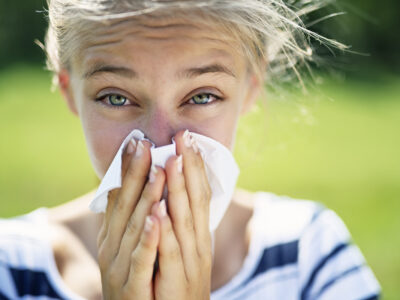Table of Contents[Hide][Show]
Ah-choo!
Sneezing and sniffling your way through another cold and flu season?
Wait!
Before you reach for that cold remedy, it may actually be something else.
Your sneezing—and other symptoms—might be due… allergies.
Let’s take a closer look at winter allergies, including what causes them, their main symptoms, and what you can do to feel better.
What Are Winter Allergies?
Seasonal allergies are most often associated with spring, when plants are blooming and pollen is in the air.
But allergies can strike any time of the year, and you can easily be one of nearly 50 million Americans who suffer from winter allergies.
However, there’s one thing that sets winter allergies apart from other types of seasonal allergies.
Location.
Other seasonal allergies are outdoor-based, brought on by exposure to flowers, plants, trees, grass, and even weeds.
Winter allergies, on the other hand, are mostly brought on by being indoors.
In fact, that same cozy room that entices you to curl up under a blanket with a cup of hot cocoa could be the source of your sneezing, sniffling, and other symptoms.
And the more time you spend indoors, avoiding the cold, the more you increase your exposure to the allergens that are indoors with you.
What are those allergens?
Let’s take a look at the most common causes of winter allergies.
What Causes Winter Allergies?
The most common causes of winter allergies are found right where you spend your days hiding from the cold: indoors.
Winter can bring on your allergies for a couple of reasons.
- You’re spending more time indoors, which increases the amount of time you’re exposed to the most common winter allergens.
- The things you do to seal in the heat—sealing drafts, closing windows, insulating the house—also seal in allergens. Without fresh air circulating through your home, the allergens have nowhere to go.
But what, exactly, is triggering your allergies?
Dander
Are your pets staying warm indoors with you? If so, they could be one of your winter allergy triggers.
Also called animal dander or pet dander, dander is dead skin cells that flake off animals with fur or feathers.
Dander is incredibly lightweight, so it can easily become airborne. Its lightness means that it will linger longer in the air, where it can make its way to you and your nasal passages.
Danders’s microscopic size makes it imperceptible, while its jagged edges allow it to attach easily to furniture, bedding, curtains, and other textiles.
Dust Mites
Did you ever walk into a dusty room and start sneezing?
If so, it’s not the dust that triggers your allergies; it’s the dust mites.
One of the most common indoor allergens, dust mites are microscopic bugs that live in house dust. You can’t see them, but they live in upholstery, carpets, and other fabrics found throughout your home.
Dust mites feed on flakes of dead skin shed by humans or animals, so they’re especially attracted to your bed and bedding. During the winter months, when many people use extra bedding or throw blankets, dust mites flourish.
Indoor Pests
The cold winter weather doesn’t just drive you indoors. All sorts of creatures seek the warmth of a home, including indoor pests such as cockroaches and mice.
Indoor pests walk across your floors and other surfaces, leaving behind feces, saliva, and other fluids that can trigger your winter allergies.
Related
Why Is Mold Dangerous?
Learn more about the dangers of mold, signs that it’s present, who is most at risk, and how to prevent it from growing in your home.
Mold
Another big winter allergy trigger is mold.
Mold is a fungus, which can trigger an allergic reaction when it releases spores.
Although the mold in your home might be present all year, the extra time you spend indoors during the winter heightens your exposure.
Other Winter Allergies
But one type of winter allergy trigger isn’t found indoors…
Because if you live somewhere with warm weather, there may still be local flora releasing pollen or other allergens.
If you’re sniffling or feeling other allergy symptoms when you spend time outdoors, consider using a saline spray or nasal irrigation device to clear your sinuses.
Winter Allergy Symptoms
When the allergens mentioned above enter your body, your immune system takes notice. It may react by producing antibodies to attack these foreign substances, just as it does when it encounters bacteria or an infection.
It’s your immune system’s response, and in some cases over-response, that causes your winter allergy symptoms.
Here are some of the symptoms you may experience if you have winter allergies. (You’ll notice how similar they are to other seasonal allergies.)
- Coughing
- Dark circles under your eyes (even if you’re getting enough sleep)
- Drowsiness or fatigue
- Dry, itchy skin
- Headaches, especially in the morning
- Itchy, watery eyes
- Postnasal drip
- Runny or stuffy nose
- Skin rashes
- Sneezing
- Sore or itchy throat
Winter allergies can also activate allergic asthma, leading to wheezing and shortness of breath.
Related
5 Indispensable Tips for Treating Dry Skin
Let’s review 5 tips for treating dry skin—everything from tweaking your self-care routine and environment to eating the right foods.
Is It Winter Allergies, a Cold, or the Flu?
As you may have noticed from our list, winter allergy symptoms are incredibly similar to the symptoms of a cold or flu.
So how do you know what’s causing your symptoms?
- Body aches: If your body feels sore and achy, it’s most likely a cold or flu. Allergies don’t usually come with body aches.
- Duration: A cold or flu should only last 7–10 days, maximum. Winter allergies, on the other hand, are seasonal allergies and can last the entire winter season—weeks or even months.
- Itching: Do your ears, eyes, nose, skin, or throat feel itchy? Then it’s probably allergies.
- Mucus/phlegm: Allergies tend to produce clear, watery phlegm. If you have a cold or the flu, mucus and/or phlegm may be thicker and turn green or yellow as your symptoms develop.
How to Manage Winter Allergies
If you’ve run through the list of symptoms and determined that you’re experiencing winter allergies, you don’t have to suffer until spring!
Here are some simple yet highly effective ways to reduce the allergens in your home and lessen your winter allergy symptoms.
To Reduce Pet Allergies
- If you have a pet indoors, clean frequently. Sweep up visible hair, then follow up with a mop. Use a vacuum cleaner on upholstery and other fabrics.
- Wash your hands frequently when you’ve petted or played with your pets.
- Create a “no-pet zone” in your bedroom, to minimize your exposure to allergens and allow you to sleep better.
- Groom pets regularly and give them weekly showers.
To Eliminate Mold
- Run bathroom exhaust fans after showers or baths, to get rid of moisture.
- Use the kitchen exhaust fan when you cook, especially if you use the oven or stove for a prolonged time.
- Throw out shower curtains, sponges, or any other item that exhibits mold.
Related
Fight Allergies Through Your Gut
It is almost the end of summer, which means yet another allergy season for some of us. If you find yourself scrambling to find a remedy, it may be time to look within, deep within, as in your gut. I just returned from a two-week trip to Asia and avoided Montezuma’s revenge, aka Bali belly, …
To Lower Other Allergens
- Establish and maintain a regular cleaning routine that includes dusting surfaces, sweeping and mopping floors, and vacuuming furniture.
- If possible, replace carpeting with other flooring materials. Roll up and store rugs for future use, or vacuum them regularly.
- Wash bedding, slipcovers, and other textiles often and in hot, soapy water.
- Wear a mask when cleaning. It may seem contradictory, but the very things you do to clean your home, such as dusting furniture and changing bedding, can release dust mites and worsen your symptoms.
- Use allergy-proof covers on mattresses and pillows.
- Don’t let food be a pest temptation! Store food tightly, run the garbage disposal, and take trash outdoors as soon as possible. While indoor pests can be found in even the cleanest home, they are drawn to trash.
- Make sure your vacuum cleaner has a HEPA (high-efficiency particulate air) filter, which will allow it to capture tiny allergens such as dander, dust mites, and more.
- Wash stuffed animals often, especially those kept in a child’s bedroom.
In General
- Wash your hands and shower often, especially when you feel you’ve been exposed to an allergy trigger.
- Control the humidity in your home, keeping it below 50%. Both dust mites and mold thrive in high humidity.
- Reduce clutter to make your home easier to clean and give allergens less surfaces to land on.
- Take an immune supportive supplement. With Just Thrive Probiotic and Ultimate IgG, you promote good gut health, immune health, and overall well-being. Ultimate IgG also helps balance your body’s immune response so that it doesn’t overreact to allergens, keeping allergic symptoms and inflammation to a minimum.
Remember, indoor allergy triggers are present everywhere, not just in your house. When you first get home from work, a restaurant, the gym, or anywhere else, consider changing clothes or even showering before getting comfortable on your couch.
Final Thoughts
Winter allergies are easily confused with a cold or flu, due to their similar symptoms.
But if you notice your symptoms lingering longer, then it’s a sign that you might have winter allergies.
Unfortunately, your allergies won’t go away… but their symptoms can!
Follow the tips we shared above to reduce or even get rid of the allergens in your home, and you’ll be breathing easy and feeling allergy-free before the winter is over.
You May Also Like…







